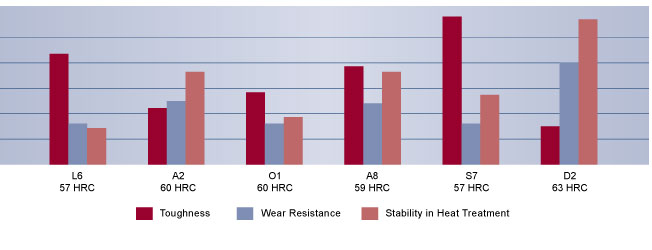L6 Tool Steel
L6 Tool Steel is a versatile, oil-hardening tool steel that is characterized by very good toughness. L6 tool steel is suitable for use as tools, dies, and machine parts, which require a good combination of hardness and toughness. The relatively high nickel content results in an alloy with greater impact toughness compared to the other common oil-hardening grades.
APPLICATIONS: Punches and dies, cold forming tools, and coining dies.
Composition
| C | Mn | Si | Cr | Ni |
| 0.70 | 0.60 | 0.25 | 0.70 | 1.40 |
Relative Properties


Physical Properties
- Density: 0.284 lb/in3 (7861 kg/m3)
- Specific Gravity: 7.86
- Modulus of Elasticity: 30 x 106 psi (207GPa)
- Machinability: 75% of a 1% carbon steel

Heat Treating Instructions
Hardening
Critical Temperature: Ac1: 1325°F (719°C)
Preheating: Heat at a rate not exceeding 400°F per hour (222°C per hour) to 1150-1250°F (621-677°C) and equalize.
Austenitizing (High Heat): Heat slowly from the preheat.
Furnace or Salt: 1450-1500°F (788-816C)
Soak for 30 minutes for the first inch (25.4 mm) of thickness, plus 15 minutes for each additional inch (25.4 mm).
Quenching: Oil to 150-125°F (66-51°C).
Note: Sizes under 3 inches (76.2mm) in cross section will achieve moderate hardness by cooling in a blast of air or pressurized gas.
Tempering: Temper immediately after quenching. Hold at temperature for 1 hour per inch (25.4 mm) of thickness, 4 hours minimum, then air cool to ambient temperature.
To minimize internal stresses in cross sections greater than 6 inches (152.4 mm) and to improve stability in tools that will be EDM'd after heat treatment, a soaking time of 8 to 10 hours at the tempering temperature is strongly recommended.
Cryogenic Treatment: Some prefer to do cryogenic treatment as an extension of the quench from the austenitizing treatment. Others prefer to cryogenically treat after tempering.
Annealing
Annealing must be performed after hot working and before re-hardening.
Heat at a rate not exceeding 400°F per hour (222°C per hour) to 1400°F (760°C), and hold at temperature for 1 hour per inch (25.4mm) of maximum thickness; 2 hours minimum. Then cool slowly with the furnace at a rate not exceeding 50°F per hour (28°C per hour) to 1000°F (538°C). Continue cooling to ambient temperature in the furnace or in air. The resultant hardness should be a maximum of 235 HBW.
For improved machinability, hold at 1400°F (760°C) for1 hour per inch (25.4mm) of maximum thickness; 2 hours minimum. Then cool slowly with the furnace cool from 1400°F (760°C) to 1250°F (677°C), hold for 8 hours, then air cool to ambient temperature. The resultant hardness should be a maximum of 192 HBW.